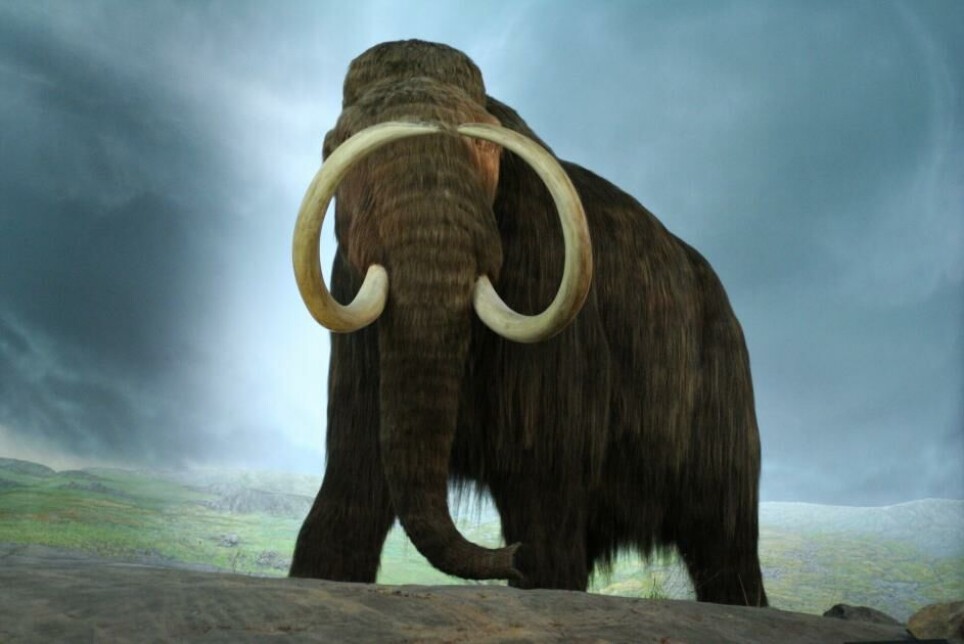THIS ARTICLE/PRESS RELEASE IS PAID FOR AND PRESENTED BY University of Oslo - read more

Revealing the last meal can solve a 12.000-year-old cold case
The landscape where the mammoths lived is often pictured as a dry, cold steppe. But this may not be true according to a new study.
Traditionally, remnants of megafauna, pollen, and seeds have been used to reconstruct how the landscape must have looked like during the Ice Age. This period, called the Pleistocene, is rather different from what the world looks like today. For one, Siberia, Alaska, and Northern Canada were connected to form a land bridge called Beringia.
This is where the woolly mammoth (Mammuthus primigenius) and other emblematic megafauna lived, but what did all these huge animals eat? Where they just living of grasses, or did they have a more varied diet? When scientists started to investigate this, they found out that there was more variation in the vegetation than previously thought. They also solved a cold case finding the cause of death of an unfortunate bison.
New methods on old samples
Marcel Polling, a PhD at the Naturalis History Museum of Oslo and Naturalis Biodiversity Center (Netherlands) is one of the researchers who looked at the old, but perfectly permafrost preserved dung samples. He is a palynologist – an expert on pollen. A problem in pollen research is that many plant species produce pollen that look the same. He used DNA metabarcoding to identify plant fragments and pollen on a species level. He wanted to know if this technique was applicable for old samples.
Pollen has, for a long time, been used in paleontology to date sediments or ice layers, or to reconstruct the ancient environments. Pollen analysis has been the golden standard for a long time.
Polling used DNA metabarcoding on thousands of years old dung samples from the permafrost in Russia. The oldest samples were about 28.600 years old. In samples this old, DNA is often degraded. This means that it is hard to get long stretches of DNA from a sample. Methods that work well on present day samples, may therefore not work in an older sample. Polling tried different DNA metabarcodes to find one that works on such old material. He found that a shorter DNA metabarcode gave good results. It worked so well, that the typical image of the so called mammoth steppe must be redrawn with patches of rich shrubs and marshy wet areas, according to the plant material in their findings.
The mammoth diet
When Polling and the other researchers looked at what the mammoths had eaten, they were surprised:
“We found some species in these samples that lived in particular environments. We can now reconstruct the environment in very high detail. For example, we now know that some mammoths lived in a wet environment, while others may have lived in a drier one,” says Polling.
Previous pollen-based studies found mostly grass-pollen from these samples, and the result is that the representation of the age of the mammoths is a typical open grass land. These studies do not represent the full diversity of this age, and according to Polling the grasses and other plants producing large amounts of pollen make them dominate the findings.
This kind of sampling will give an idea about what the animals last meal was, but not a full overview of the diet. This is because one meal may be affected by the season and the plants available at that moment. Using this method for reconstruction of the landscape is also biased towards plants that were particularly chosen.
The cold case of a dead bison
In addition to mammoth, the researchers looked at a steppe bison, two prehistoric horses, and recent caribous (reindeer).
“We found a high amount of DNA from very poisonous water hemlock (Cicuta virosa) in the faeces of a dead bison, which means that the animal must have eaten a lot of it. Today animals die from eating this plant, so we can reconstruct the death of this bison,” Polling explains.
In the horse and mammoth-dung he found a big diversity of flowering plants, indicating that these animals had a much more varied menu than previously thought. Today’s horses are mostly grazers feeding almost exclusively on grasses, but the faeces of these ancient horses show that they had a more varied diet at that time, also living in a marshy wetland.
The result of this work shows that these new techniques can be used to study the environment that these animals lived in, in unprecedented detail.
Reference:
Marcel Polling et.al.: Multiproxy analysis of permafrost preserved faeces provides an unprecedented insight into the diets and habitats of extinct and extant megafauna. Quaternary Science Reviews, September 2021.
See more content from the University of Oslo:
-
Queer opera singers: “I was too feminine, too ‘gay.’ I heard that on opera stages in both Asia and Europe”
-
Putin’s dream of the perfect family
-
How international standards are transforming the world
-
A researcher has listened to 480 versions of Hitler's favourite music. This is what he found
-
Researcher: "AI weakens our judgement"
-
New, worrying trend among incels, according to researcher





































